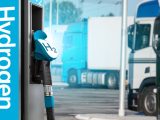
World’s largest hydrogen power plant and electrolyzer to open in Australia
February 9, 2023The facility will be substantially larger than anything running today.
South Australia plans to bring an ambitious green energy project to fruition by building the largest hydrogen power plant in the world, which will be home to an electrolysis facility that is ten times bigger than any other H2 power station currently in operation.
The plant will absorb extra renewable energy from the state’s grid.
Additionally, the hydrogen power plant will run the excess green energy through a massive 250-megawatt (MW) electrolysis facility, allowing for the production of large amounts of hydrogen. The hydrogen that is created will be stored on site.

The plan is to run the hydrogen through a 200-MW generator facility and put energy back into the grid during times when renewable energy production is at its lowest, during the evenings and through winter months. The hydrogen will either be burned to drive steam turbines or it will be converted back to electricity via a massive fuel cell stack.
The hydrogen power plant will help to prevent strain on the grid.
The goal of the green hydrogen plant is to help balance supply and demand in the South Australian grid. Presently, more than 69% of all South Australia’s electricity is generated from solar and wind energy, and it’s expected to generate 100% from renewables before 2030.
Currently, the Australian’ state generates more solar power than it can consume, to the point that the government has previously requested consumers to turn on as many appliance as possible to avoid an electricity overload. The plan is to operate the electrolyzer during the day, when solar energy production is at its peak, and then shut it off at night.
According to Sam Crafter, the CEO of the Office of Hydrogen Power South Australia, by building a world leading project, the hope is that it will lead to larger projects, at the neighbouring Port Bonython green hydrogen hub and at the steel city of Whyalla.
“It will be…the launching pad to get to those larger scale projects that the industry is rushing towards,” Crafter told Renew Economy.
The hydrogen power plant will be developed by the Office of Hydrogen Power South Australia. The project will receive funds of AU$600 million (US$414 million) from the South Australian State Government and be constructed near the city of Whyalla, about 100 km northwest of Adelaide. The plant is expected to be operational by 2025.



 With over 15 years of reporting hydrogen news, we are your premier source for the latest updates and insights in hydrogen and renewable energy.
With over 15 years of reporting hydrogen news, we are your premier source for the latest updates and insights in hydrogen and renewable energy.
Sounds great! Hope many other organizations get with it too.
Lots of states & nations are looking at H2 energy but no-one dares to be first. Until now. Well done, SA.
Also, excited to see what they can do for carbon free steel in Whyalla.
Germany is looking seriously at H2 storage and has several projects in progress because the HAVE to. The USA is dominated by Petrodollar and Electrical Utility lobbyists. H2 creation & use in-state displaces gas sales and gas wheeling fees. Electrical energy creation in state decreases electrical wheeling revenues to Electrical Utilities. All of this is opposed by industry lobbyists feeding information to the largely non-technical elected representatives. Until we’re desperate or the lobbyists money spigot get metered, not much will change. There are NO technical hurdles to overcome, just human greed.
Burning the hydrogen will creat oxides of nitrogen….poisonous
Better to use fuel cells to convert Hydrogen directly into electric current
Even better store the surplus electricity in Zinc Bromine flow batteries, and release the current when it’s required.Also they don’t catch fire like Teslas storage batteries
Australia already has a good domestic manufacturer of these flow batteries which are reliable and long lasting so why on earth look elsewhere?
“Burning the hydrogen will create oxides of nitrogen….poisonous”
Someone needs to research combustor technology advances since 1955.
H2 storage in developed salt formations (Just like Natural Gas) are the cleanest, cheapest method. Storage in existing oil wells is another cheap, accepted methodology. Neither involve mining battery materials and using low power density per unit storage, time degradable, methodologies. Stationary power plants just need cheap, high capacity storage. Weight and footprint for energy storage aren’t an issue with most power plants. For high power density per unit the simplest methodology is to create synthetic diesel, gasoline, jet fuel with existing hydrocarbon chemistry using the H2 stream and waste carbon sources, even atmospheric CO2. Just make “renewable green gas/diesel”, the tech is already there.
I agree that flow batteries are underutilized. For isolated communities they make a lot of sense and are easier for local folks to maintain. For Utility Grade energy storage, not so much.
Great idea I really believe hydrogen is the answer to our future energy needs!
Great news from South Australia . Perhaps the UK will follow suit one day!
It is time that the world got rid of the filthy diesel locomotives fo boh freight and passenger trains.
Hydrogen fuel cells is the answer. My PhD thesis is based on converting disel locomotives to hydrogen fuel cells using permanent magent 3-phase motors and DTC inverters to contron the slip/slide of the bogie wheels.